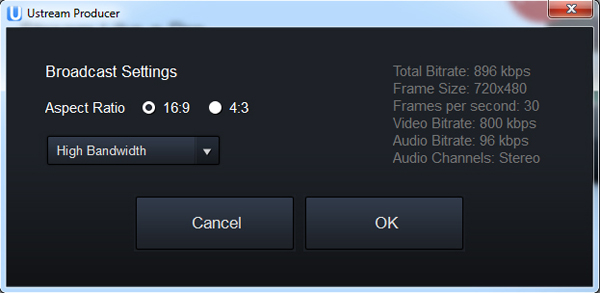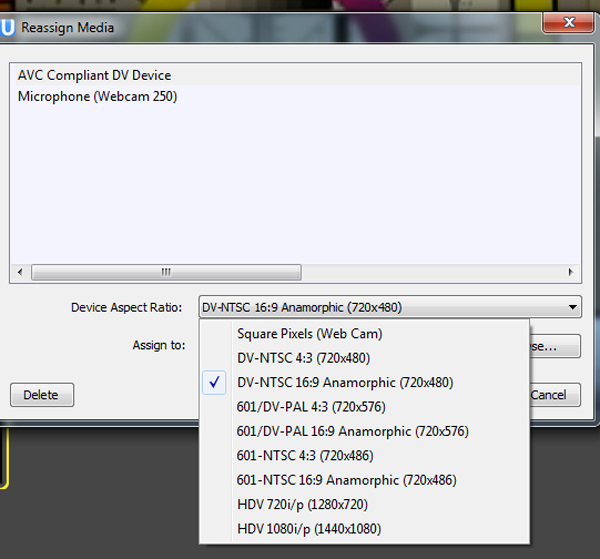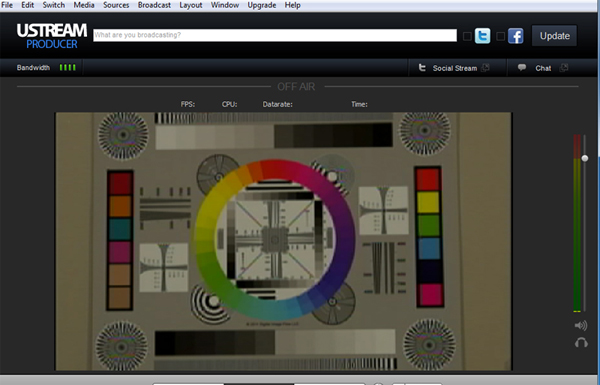Review: Roland VR-3 All-In-One A/V Mixer—UPDATED!
If you're in the market for an all-in-one video mixer for webcasting 4:3 NTSC video, Roland's compact new VR-3 fits the bill nicely. If you need widescreen video output, you may need to add some steps to your workflow when you pair NTSC widescreen video with many of the popular streaming services.
Streaming VR-3 Output with USTREAM Producer
USTREAM lists four options for broadcasting here. I've already explored their default Web Broadcaster, and Adobe's Flash Media Live Encoder and webcasting from a mobile device aren't applicable for our VR-3 workflow, so that leaves us with a final option: USTREAM Producer (free or Pro).
USTREAM Producer is a white-label version of Telestream's popular Wirecast software solution . When I first tested Producer I didn't have any success with getting widescreen video to display properly, as it shared the same confusing 16:9 and 4:3 settings as the web-based broadcaster, which served only to crop the video but not correct pixel aspect ratio.

Ustream Producer Broadcast Settings for 16:9
I dug a little deeper into the menus and under MEDIA I found the solution in Show Asset Manager. This launched a Reassign Media dialog box, which allowed me to assign a different aspect ratio to my input devices.

Ustream Producer Asset Manager > Reassign Media
By this point I had already returned my loaner Roland VR-3 so I tested with the Canopus Twinpact 100 (shown as AVC Compliant DV Device) and was able to output widescreen video output with a full 720x480 resolution and a proper 1.2 widescreen pixel aspect ratio. Because the issue is in the output settings in the web-based streaming service, this workflow would produce proper widescreen video with the VR-3 as well.

Ustream Producer 16:9 output
I still prefer using Adobe FMLE for this as I can force a square pixel output, rather than an anamorphic output, because this is easier on the viewer in terms of CPU/GPU load.
Recommended Modifications to the VR-3
It turns out Adobe FMLE was what I needed to properly stream square pixel widescreen video output from the VR-3, and I was pleased to discover in my second round of testing that I could achieve widescreen output using certain settings in Ustream Producer, but I can’t help but feel that this process should be simpler for the webcaster. The type of user who is going to be utilizing the VR-3 may not want to deal with the added complexity of a content delivery network or an additional layer of settings when the branded streaming services are supposed to make the process so easy.
My simple idea for Roland is to convert the USB output (only) from its native NTSC to 864x480, the square pixel equivalent of widescreen NTSC. While they are at it, they might as well add a 640x480 option for 4:3 video. Outputting square-pixel video would make the output compliant with the web-based Flash consoles on the streaming services they list, and the added benefit is that if the pixel aspect conversion is hardware-driven on the VR-3 side, it eliminates a software conversion on the computer side. Alternatively, they could add a widescreen pixel aspect ratio option to their USB output as this might solve the web-based Flash console display problem.
My test system for my streams is a massive workstation that can handle the additional aspect ration processing, but I can see many users wanting to pair the VR-3 with a laptop, which may lack sufficient processing power to convert and encode without dropping frames. Perhaps this can be accomplished with a firmware update.
If you’re in the market for an all-in-one video mixer for webcasting 4:3 NTSC video, the VR-3 fits the bill nicely. If you need a widescreen video output make sure you can deal with the attendant challenges when you pair NTSC widescreen video with many of the popular streaming services.
Related Articles
This capture software was developed to meet the request from Windows users who want to record/capture the audio and video during live events using any of the products from the Roland VR or VC line-up
New switcher designed for live events and installations, augments V-1600HD and V-800HD lineup with 12 inputs on 4 channels plus 1 (background), and 2 output buses with independent scalers on the inputs and outputs allowing you to connect HDMI/DVI, RGB, component, and composite sources
Video production and encoding expert Jan Ozer describes the workflow and challenges of a Livestream webcast he produced for marimba player Larissa Venzie using the Roland VR-3 and Next Computer's Radius portable workstation.